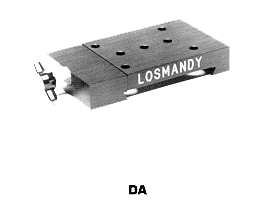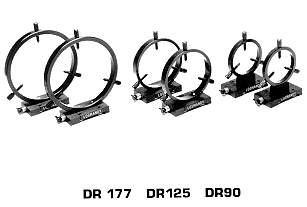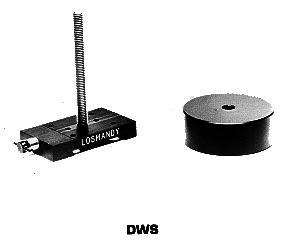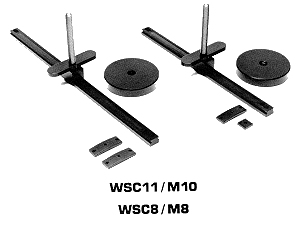C-7 Home Page ![]() C-7 News
C-7 News ![]() Consignment
Consignment ![]() Library
Library ![]() Products & Services
Products & Services ![]() Product Lines
Product Lines ![]() Order
Order ![]() Search C7.com
Search C7.com
Losmandy Overview ![]() Distribution
Distribution
![]() News
News ![]() Notes & Interesting Articles
Notes & Interesting Articles ![]() Pricing
Pricing
![]() Products
Products

LOSMANDY HOLLYWOOD GENERAL MACHINING ACCESSORIES
"Innovative mechanical design, manufacture by in-house computer controlled manufacturing equipment operated by an experienced staff... a high degree of consistency and performance that is unmatched in its respective price ranges."
Note: Dovetail components are designed so that no tools are necessary to exchange accessories, or make position adjustments.
Model DSBS Side by Side Mount "D" Series Plate:
| When installed (slide on) onto any Losmandy "D" Series Dovetail Saddle Plate (such as is furnished on the G-11 Mount) this allows two instruments to be mounted side by side. |  |
Keep in mind that the total payload rating of the telescope mount should not be exceeded. The use of this plate with extra loads may require you employ (or purchase) additional counterweights.
Weight: 7.25 lbs.
Model DMM Double Male "D" Series Plate:
When installed (slide on) onto any Losmandy "D" Series Dovetail Saddle Plate this allows Losmandy "D" Series Dovetail adapter, Piggyback mounts and Positioning stages to be installed.
Weight: 2.6 lbs.
Model DCM1 Dual Axis Camera Mount:
| When installed (slide on) onto Model DMM Double Male "D" Series Plate, or onto a "D" Series plate (such as underneath and forward on a Celestron CG-11 telescope) this allows a camera or CCD Head with lens to be attached by means of the 1/4"-20 thread screw knob. |  |
Common applications include: Piggyback astrophotography.
The primary difference between this and the following "DCM" is that adjustments of positioning may be made not only in azimuth (left-right) but in elevation (up-down).
Weight: 2.0 lbs.
Model DCM Single Axis Camera Mount:
When installed (slide on) onto Model DMM Double Male "D" Series Plate, or onto a "D" Series plate (such as underneath and forward on a Celestron CG-11 telescope) this allows a camera or CCD Head with lens to be attached by means of the 1/4"-20 thread screw knob. Or, if two are used in series on a "D" Series plate, then a photo guide telescope or other instrument parallel to the main telescope may be accommodated (even though other mount options we offer are preferable).
Common applications include: Piggyback astrophotography.
The primary difference between this and the preceding "DCM1" is that adjustments of positioning may be made only in azimuth (left-right) but not in elevation (up-down).
Weight: 1.2 lbs.
Model DA Dovetail Adapter Mount:
| When installed (slide on) onto Model DMM Double Male "D" Series Plate, or onto a "D" Series plate his allows a camera or CCD Head with lens to be attached by means of the 1/4"-20 thread screw knob. Or, if two are used in series on a "D" Series plate, then a photo guide telescope or other instrument parallel to the main telescope may be accommodated (other mount options we offer may be preferable). |  |
Common applications include: Piggyback astrophotography, mounting guide scope, or a small primary telescope.
The primary difference between this and the preceding "DCM1" is that adjustments of positioning may be made only in azimuth (left-right) but not in elevation (up-down).
Weight: 12 oz.
Model PBC11/M10 or PBC8/M8 Piggyback Mount:
| When installed (slide on) directly onto a telescope, this allows a camera or CCD Head with lens to be attached by means of the 1/4" - 20 thread screw knob onto a movable base; this base can be positioned and locked at any position on the dovetail rail. The base can be removed from the rail to facilitate mounting the camera or other system onto the base. The length of the rail is tailored to fit onto the specified telescope: Celestron or Meade 8, 10, or 11 inch aperture Schmidt-Cassegrain Telescope. |  |
One of the main advantages of this system is that the piggybacked load can actually be moved forward or back on the rail to act as a counterbalance in Declination. Furthermore, when using a very wide angle camera the camera may be moved forward nearer to the end of a telescope to reduce the possibility of the telescope appearing in the photograph.
Weight: 2.5 lbs.
Model DR177, DR125, DR108, DR90 PhotoGuide Telescope Mounts:
| Each two piece set consists of a DA Dovetail Adapter which slides or clamps onto a "D" Series plate, or onto a Model DMM Double Male "D" Series Plate. Onto this DA Adapter is installed a precisely machined guide scope mounting ring each with three machined adjustment screws fitted with non marring high density plastic tips. These screws permit the easy and precise adjustment of any installed guide telescope to line up with the primary instrument. The available mounting ring diameters are: |  |
- 90mm (3.5") With inner diameter size from 1.7" to 3.5"
- 108mm (4.25") With inner diameter size from 2.45" to 4.25"
- 125mm (5.0") With inner diameter size from 3.1" to 5.0"
- 177mm (7.0") With inner diameter size from 5.4" to 7.0"
Common applications include: Mounting a photoguide telescope scope onto a telescope or other platform.
A particular advantage of this system is that any installed photoguide telescope can be moved forward or to the rear by sliding the guidescope with the rings, or if necessary moving the scope within the rings for use effectively as a Declination counterweight system.
Model RDF90 And RDF70 Telescope Quick Release Mounts:
| Each is a two piece assembly consisting of a Base that has a two hole mounting pattern drilled that matches the accessory hole mounting pattern of most common telescopes made by companies such as Celestron, and Astro-Physics. With the Base installed, one can then slide either the 70mm (2.75 inch) or 90mm (3.5 inch) inner diameter rings into place with a small telescope in place - usually a finder telescope. The six machined adjustment screws of the 90mm model are fitted with non marring high density plastic tips while the 70mm employ nylon non marring screws; these screws permit the easy and precise adjustment of any installed accessory telescope to line up with the primary instrument. |  |
The available mounting ring diameters are:
- 90mm (3.5") inner diameter size 1.7" to 3.5"; ring separation 5.0". Weight 12 oz.
- 70mm (2.75") inner diameter size 1.8" to 2.75"; ring separation 3.0". Weight 8 oz.
Optional bases are available so that one may quickly interchange the mounting rings from one platform to another.
Common applications include: Mounting a finderscope (or small photoguide scope) onto a telescope or other platform.
Model DWS Counterweight System:
| When installed (slide on) onto Model DMM Double Male "D" Series Plate, or onto a "D" Series plate (such as underneath and forward on a Celestron CG-11 telescope) allows compensation of additional or changing loads on a telescope mount. |  |
The DWS is a three piece assembly consisting of a model DA mount threaded to accept a stainless steel rod; this rod has a rubber pad at the head where it threads into the DA and presses against the "D" plate. Then entire assembly can be moved back and forth along the "D" plate. A 5 lb. counterweight and locking bar are moved up and down the threaded rod to a desired position to exert the desired leverage and then locked in place.
Common applications include: Counter weighting declination for the Celestron CG-11/14 telescopes, and similar uses.
Model WSC11/M10 or WSC8/M8 Counterweight System:
| When installed (slide on) onto the appropriate telescope, allows compensation of additional or changing loads on a telescope mount. |  |
These are each a three piece assembly consisting of a dovetail bar which is attached onto the telescope optical tube assembly. A sliding bracket on this bar accepts a stainless steel rod; this rod has a rubber pad at the head where it threads into and presses against the dovetail bar functioning as a brake. The bracket/rod assembly can be moved back and forth along the bar. A 2.5 lb. counterweight and locking bar are moved up and down the threaded rod to a desired position to exert the desired leverage and then locked in place.
Common applications include: Counter weighting declination for the Celestron CG-11/14 telescopes, and similar uses.
Model DSCH Optical Encoder System:
A set of two encoders, housings, and required installation hardware that when installed (bolt on) onto the GM-8 or G-11 telescope mounts, transmits telescope position data to optional display and navigation accessories. This aluminum hardware matches the Losmandy mounts in finish and quality of execution. It is the most durable of the after market encoders available for these mounts.
These are two basically symmetrical assemblies each consisting of a 2048 Tic/Revolution optical encoder which is installed within a precisely machined black anodized aluminum housing. One encoder housing is attached onto the mount Right Ascension axis assembly. The other encoder housing is attached onto the mount Declination axis assembly. Onto each axis is placed (between the manual clutch adjustment knob and the housing of the Dec. or R.A. shaft) a precisely machined, black anodized aluminum gear. A second gear is installed onto the encoder shaft, and then adjusted to mesh with the larger gear. This 2:1 gearing ratio results in an effective +4096 Tic./Revolution.
A "Y" cable specific only to the Losmandy encoder boards is provided by Company Seven to connect the two encoders to an optional device when the customer orders this encoder set from us.
Common applications include sending signals to devices such as our JMI NGC-Max, Mini-Max, Micro-Max Series of Digital Setting Circles / Aids to Celestial Navigation, via an interface to a computer RS-232/422 interacting with astronomy programs on personal computers (such as "TheSky" and "Voyager").
Contents Copyright 1994-2002 Company Seven - All Rights Reserved

